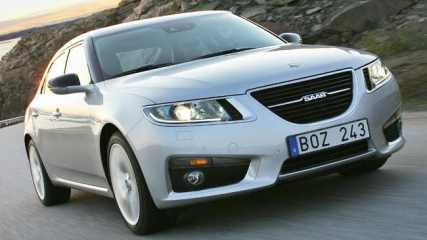Saab 9-5 2011 review: road test
By Paul Gover · 14 Apr 2011
A new flagship is waving the Saab flag again in Australia. The all-new 9-5 is the first newcomer since the Swedish brand was released from more than 20 years of suffering under General Motors, and comes with the promise of value pricing, impressive quality and styling that breaks away from the origami school of creasing in European design.Now, if only they could get the ride and handling right... The 9-5 is a good looking car that's noticeably bigger than any previous model to wear the badge, and a bottom line from $71,900 - helped by a Luxury Car Tax break for an eco-friendly diesel engine - will help to get it on shopping lists against everything from the BMW 5 Series and Benz's E Class to the Volvo S80.Saab Cars Australia is planning a slow burn on the 9-5 - and the rest of its comeback plan - and is only predicting around 100 sales this year. "Our brand is not something we shout about. We want to talk to people individually," says Steve Nicholls, managing director of Saab Cars Australia. He says the point of difference for the 9-5 is the way it looks."All our communciations are based around design. That's the key message. It's not about kilowatts or how much you can fit in the boot," says Nicholls, who flew global design boss Simon Padian to Australia for the introduction of the 9-5.VALUEThe starting price of the 9-5 is helped by a diesel that comes in at 6.8 litres/100km, but even the petrol-powered Vector is affordable - for the class - at $75,900. The flagship Aero Turbo6 XWD is priced from $94,900 with all-wheel drive and most of the good luxury stuff, although a back-seat DVD system is an extra-cost option.Good stuff on the Vector includes a head-up instrument display and chilled glovebox in addition to the usual satnav, an all-speaker Harmon-Kardon sound system, leather trim, bi-Xenon lamps and more. The top-line car is boosted by park assist, sports seats cornering headlights and more. Every 9-5 comes with keyless entry and the start button is in the console between the seats, the traditional location for the ignition key in any Saab. "We've created a big gap now between the 9-3 and the 9-5," says Nicholls.TECHNOLOGYWhen Saab was part of the GM family, the way the company was treated was basically just child abuse. That meant investment and development was always limited, so Saab is playing catch-up. Even so, its all-turbo engine philosophy is sound, it promises body strength and safety as good as anything in the class, and there is independent rear suspension - but not in the turbodiesel.Engine outputs are 118kW/350Nm for the diesel, 162/350 in the petrol four and 221/400 in the 2.8-litre V6, with all cars using a six-speed automatic gearbox. To put the 9-5 in its place, it's just over five metres in length with a wheelbase of 2837mm, has 513 litres of boot space and a full-sized spare.DESIGNThe shape and style of the 9-5 is a welcome move away from the creases-and-crunches, origami style of so many modern European cars. It even has a blacked-out A pillar to disguise the traditional bulk around the front of a car, and an aero-influenced curving windscreen."Because we're Saab we're allowed to be different. To be honest, I think if we followed the rest of the crowd we'd lose our soul," says Saab's chief designer, Simon Padian, in Australia to preview the 9-5."Saabs have always been durable, practical cars that are designed to be used. Our customers want cars that have meaning and substance." "The 9-5 is the result of a very conscious journey. We're always looking for a way to create more desirable products."So the body is smooth an distinctive, while the cabin has a driver- focussed dashboard and the sort of quality final finishing you expect in a Saab.SAFETYThe 9-5 should easily clear the five-star bar at NCAP, but Saab says it wants more and is bringing everything from its 'black panel' dash - which blanks everything but the speedo on command to cut after-dark strain - to the head-up display. There are front-side-thorax-curtain airbags, ESP stability control and ABS brakes, as well as a rollover sensing system.DRIVINGThe look and feel of the 9-5 promises a lot. It's a classy car where you can see and touch the quality. The engines also respond well, from the quietness of the diesel to the pull of the V6, with a smooth shifting automatic - although there is no response to calls for a downchange when you tug the shift paddles in D, only in Sport.Based on a very short drive in a full range of cars, the 9-5 is fairly quiet - apart from some wind noise around the mirrors - the seats are very comfy and supportive, and the dash is well laid out with plenty of toys. The head-up display is the best we've seen but there is a silly extra display in the dash that means you can have three speedometers operating at once - main, head-up, and an 'altimeter-style' extra - and that's plain silly.The real problem with the 9-5 is the suspension. Regardless of the car, and despite running through 17-18-19 inch tyre sizes, the suspension is crude and fails to cope with Australian conditions. Saab says it wants a sporty feel, but the 9-5 crashes through potholes, is nervous on corrugations, and is generally not a nice place to travel. And there is torque steer and kickback, as well. The 9-5 is promises a lot but urgently needs to have its suspension fixed before it can be considered as a serious prestige contender in Australia.VERDICT: "Looks good, drives not so good."SAAB 9-5 ***1/2




